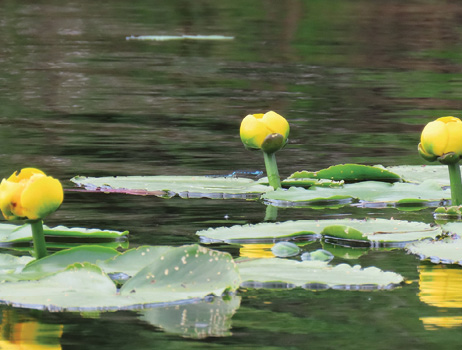Spatterdock | Nuphar advena
Emergent | Native



Spatterdock, also known as cow lily, is an attractive native species of rooted lily pad. It is a perennial plant that has spade- to heart-shaped leaves with a deep notch where the stem joins the leaf. Leaves are arranged in a spiral at the base.
Leaves can be up to 16 inches in length but are more often half that length. Leaves may be submersed, float on the surface, or emerge above it. Surface leaves are shiny green, while submersed spatterdock leaves can be almost transparent.
Flowers are small and round and extend just above the water’s surface. The petals are yellow and less showy than white water lily, Nymphaea spp., or American lotus, Nelumbo lutea. The latter two species have more circular leaves, as well.
Spatterdock fruit is egg-shaped and contains many seeds. Seeds are generally less than one-fourth inch long and slightly narrow.
Management Value
Spatterdock is an important native species in natural environments. Deer eat the leaves, beavers and muskrats will eat the rhizomes, and ducks eat the seeds. It can make excellent fish habitat in moderate densities.
This plant has been used in traditional medicine to treat a variety of conditions. People also eat the seeds or grind them into flour. The root is edible but can be quite bitter.
Spatterdock can be problematic in shallow ponds. However, for those who like aggressive management, it makes excellent fish habitat and can be introduced on small, shallow areas adjacent to deeper water. Address unwanted expansion early before the problem gets too severe.
Recommended Controls
Option 1: Flumioxazin (4.0-pound formulation). Flumioxazin (1.1 pints per acre-foot of water) should be applied as a submersed injection (application using a wand or hose). Determine pond volume prior to application. Use a buffering agent when mixing with water with pH greater than 7.0. Do not exceed annual herbicide rate limits as stated on the product label.
Option 2: 2,4-D (3.8-pound formulation). 2,4-D should be applied as a submersed injection (1.4 gallons per acre-foot of water). Determine pond volume prior to application. Do not exceed annual herbicide rate limits as stated on the product label.
NOTE: Acre-foot = average depth of pond multiplied by pond acreage; average depth is calculated by taking the depth at 20 points across a water body and averaging the values.
Submersed injection means that the herbicide solution should be applied below the surface directly into the water. The best approach is to treat ponds with herbicides when the water temperature is at least 60˚F and the plants are actively growing.
Read and follow all chemical label instructions, especially the section on the use of personal protection equipment.
Photo Credits Middle: U.S. Fish and Wildlife Service

The information given here is for educational purposes only. References to commercial products, trade names, or suppliers are made with the understanding that no endorsement is implied and that no discrimination against other products or suppliers is intended.
Publication 3735-33 (POD-11-23)
By Wes Neal, PhD, Extension/Research Professor, Wildlife, Fisheries, and Aquaculture; Dennis Riecke, Fisheries Coordinator, Mississippi Department of Wildlife, Fisheries, and Parks; and Gray Turnage, PhD, Assistant Research/Extension Professor, GeoSystems Research Institute.
Copyright 2023 by Mississippi State University. All rights reserved. This publication may be copied and distributed without alteration for nonprofit educational purposes provided that credit is given to the Mississippi State University Extension Service.
Produced by Agricultural Communications.
The Mississippi State University Extension Service is working to ensure all web content is accessible to all users. If you need assistance accessing any of our content, please email the webteam or call 662-325-2262.



